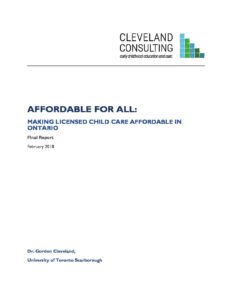A major new study (https://childcarepolicy.net/wp-content/uploads/2021/12/Ten_a_day-paper-web.pdf ) addresses the question of whether the $10 a day program will truly improve child care affordability and reduce barriers to employment for families. It was written by economists Gordon Cleveland and Michael Krashinsky from the Department of Management at University of Toronto Scarborough.
Their study focuses on the situation facing couple families with one infant child and one preschooler in each of the three provinces at different possible levels of income. The authors’ main conclusion is that the $10 a day program can and should dramatically change child care affordability and make employment a worthwhile option for many caregiving parents. However, even if provinces and territories adopt a flat fee of $10 a day, they will need to have some kind of sliding scale to ensure that low-income families are not disadvantaged.
On the basis of this work, Dr. Gordon Cleveland says
- “Ontario should sign a funding deal soon with the federal government; if they don’t reach an agreement by early next year, Ontario will lose about $1 Billion in child care funding.”
- “Our work shows that child care costs are a very large barrier to employment for many two-parent families, and that $10 a day child care will dramatically reduce those barriers.”
- “To reach an agreement, Ontario needs to develop a child care Action Plan. That plan needs to include support for dramatic expansion of non-profit child care – at least 150,000 spaces over 5 years. It needs a plan to phase-in more affordable child care, so that supply and demand increase together. And it needs plans to pay early childhood educators more so we can recruit more trained staff now.”
Finance Minister Chrystia Freeland’s April Budget is spending $30 Billion over 5 years to make child care affordable enough to eliminate this major barrier to the employment of mothers of young children across Canada. As of December 2021, nine provinces and territories have signed on to the $10 a day early learning and child care program, with Ontario being a notable holdout. This timely study seeks to determine whether the $10 a day policy gamble is likely to work, and what kind of funding reforms will make the effects more equitable.
Specific conclusions of the study include:
- Under current policies, if a couple family with two children cannot access subsidies in Ontario (and most cannot) licensed child care at any income level is remarkably unaffordable.
- If Ontario offered licensed child care at a flat fee of $10 a day per child along with the existing tax credit, a couple family with two children would pay less than 15% of the caregiving parent’s income contribution in child care fees, no matter what their income level. The child care cost barrier to employment would be dramatically reduced.
- Alberta’s new funding policies agreed to with the federal government will improve affordability, particularly for families at higher levels of income. Alberta plans to offer substantial operating grants to child care centres and homes to allow them to lower parent fees. And Alberta is extending its subsidy system to cover families with partial subsidies out to $180,000 of family income.
- The combination of grants and subsidies will still leave Calgary couple families with two children giving up more than 30% of net extra employment income if the caregiving parent earns less than $44,000 (family income of $110,000). In other words, child care will be unaffordable for these families even when Alberta’s new child care policies are fully implemented.
- Edmonton families will be better off than Calgary families because median fees start off at a lower level before the new funding programs. Only families where the caregiving parent earns less than about $18,000 (family income of $45,000) will find child care unaffordable (30% or more of the net income contribution of the second earner).
- Manitoba pioneered flat fees for child care, and operational funding to lower fees. However, its positive reputation is not supported by measures of current child care affordability.
- A flat fee of $10 a day per child (with no subsidy system) would improve affordability for nearly all couple families with two children in Manitoba except when the caregiving parent’s income is $14,000 or below. However, a flat fee will mean that affordability is always worse for families the lower their income.

